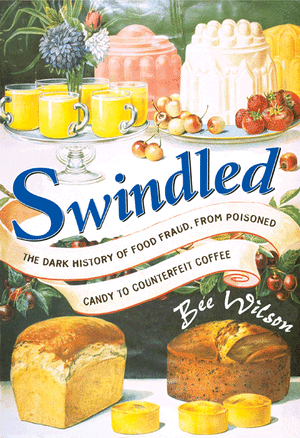
Swindled: The Dark History of Food Fraud, from Poisoned Candy to Counterfeit Coffee
by Bee Wilson
Towards the end of Swindled, Bee Wilson describes a “cruelly ingenious” method of building an egg from gelatin, benzoic acid, alum, food coloring, calcium chloride, and a few pinches of mystery powders. “If it weren’t so wicked, you could almost admire the audacity of the fraud,” Wilson writes, “the futile surrealist gesture of constructing an egg.”
But like most of the other instances of food fraud Wilson describes in her history of corrupted eats – from the harmless or even beneficial, like honey in wine or iodine in salt, to the careless or nasty, like deadly lozenges or fake milk – it is not a futile gesture. However complicated the process of faking tea and coffee or building an egg, it always has a purpose, whether it’s economic gain or (as in another of Wilson’s instances of egg-faking) rationing or consumer safety. Wilson argues that uninhibited markets allow food fraud, governments tend to belatedly and inadequately punish it, and consumers generally go along with it.
And so it has been for much of modern history. Wilson offers often gory details of the many ways to “adulterate” food (noting, interestingly, that the term has gone out of style, replaced with the less vivid concept of “food additives”). White bread, made cheaply for lower classes seeking to mimic the upper, came with a dose of the bleaching agent alum (sometimes made through a process involving urine) in 19th century Britain. Pepper contained floor sweepings, and even whole peppercorns came with “oil cakes” and clay. If your chocolate smelled of glue or cheese, you knew it wasn’t the real thing. Wine might be treated with (rather pleasant-sounding) rose petals and violets, but possibly also seawater and lead (which Wilson admits tasted fairly good).
As interesting, if less gruesome, than the adultery was the willing fakery of food in the name of safety or rationing. In wartime, Wilson writes, eating fake food like powdered milk and vegetarian meat was a patriotic virtue. Margarine and sweetener – and the ongoing debates about the pros and cons of each – were touted as healthier or less expensive than their true counterparts. (And though butter makers put up a tough fight against margarine that looked like rich, yellow butter, clever sellers simply peddled to willing consumers a dye on the side of their pale margarine). While Teddy Roosevelt read Upton Sinclair and busted the powerful beef trust, Dwight Eisenhower happily ate freeze-dried foods and powdered juice.
Which brings us to our modern age – when labels reveal too much and too little, when “organic” is more about status than meaningfully natural eats, when food scares (spinach, tomatoes and beef, to name a few in recent years) still rule. And though modern food adulteration involves broadly accepted additives and more cunning deception, the cure still seems to be a simple one, recommended by British food activist Caroline Walker, and quoted by Wilson: “Eat whole, fresh food.”
Excerpt: “[Flavourists] would say: of course you can make a delicious strawberry milkshake if you have the finest organic strawberries at your disposal, the creamiest milk, the best cane sugar. To a flavourist, the challenge is to make a convincing strawberry milkshake using no strawberries or milk, and perhaps no sugar either.”
Further reading: The Jungle and Fast Food Nation




Send A Letter To the Editors